Impact of Brand Loyalty and Consumer Satisfaction on Consumer Decision
VerifiedAdded on 2023/06/07
|25
|5983
|83
Project
AI Summary
This project investigates the impact of brand loyalty and consumer satisfaction on consumer purchase decisions within the retail industry, particularly focusing on the Saudi Arabian market. It highlights the importance of consumer satisfaction and brand loyalty as key marketing goals for organizations, leading to long-term business profits. The research explores how consumer satisfaction influences purchase intention and brand loyalty, emphasizing the role of retail companies in differentiating themselves through quality commodities and positive consumer responses. The study also examines the Saudi Arabian retail industry's growth, key players, and trends, including the shift towards modern trade and e-commerce. Ultimately, the project underscores the significance of understanding consumer behavior and enhancing brand loyalty to achieve sustainable growth and competitive advantage in the retail sector. Desklib provides access to this project and a wealth of other solved assignments and past papers to aid students in their studies.
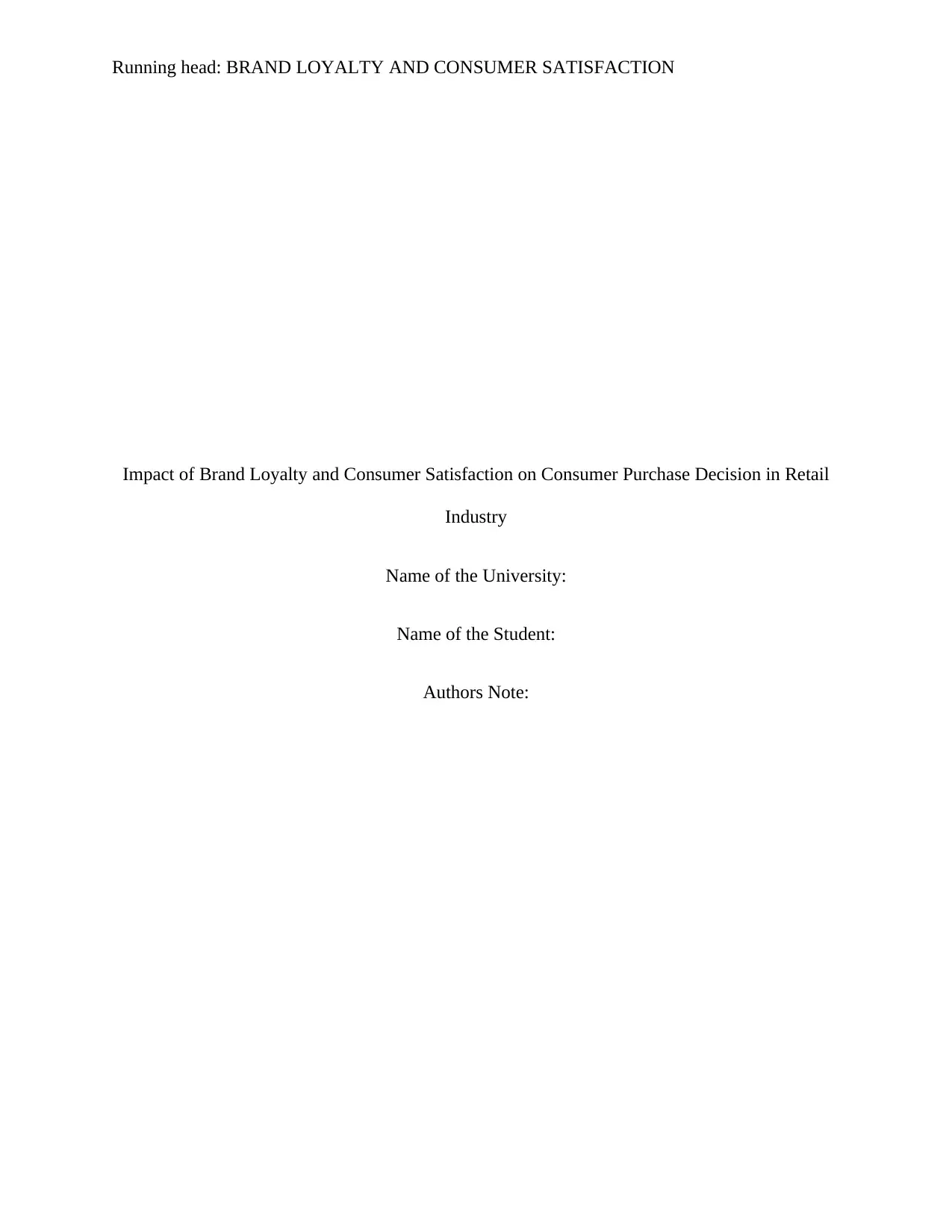
Running head: BRAND LOYALTY AND CONSUMER SATISFACTION
Impact of Brand Loyalty and Consumer Satisfaction on Consumer Purchase Decision in Retail
Industry
Name of the University:
Name of the Student:
Authors Note:
Impact of Brand Loyalty and Consumer Satisfaction on Consumer Purchase Decision in Retail
Industry
Name of the University:
Name of the Student:
Authors Note:
Paraphrase This Document
Need a fresh take? Get an instant paraphrase of this document with our AI Paraphraser
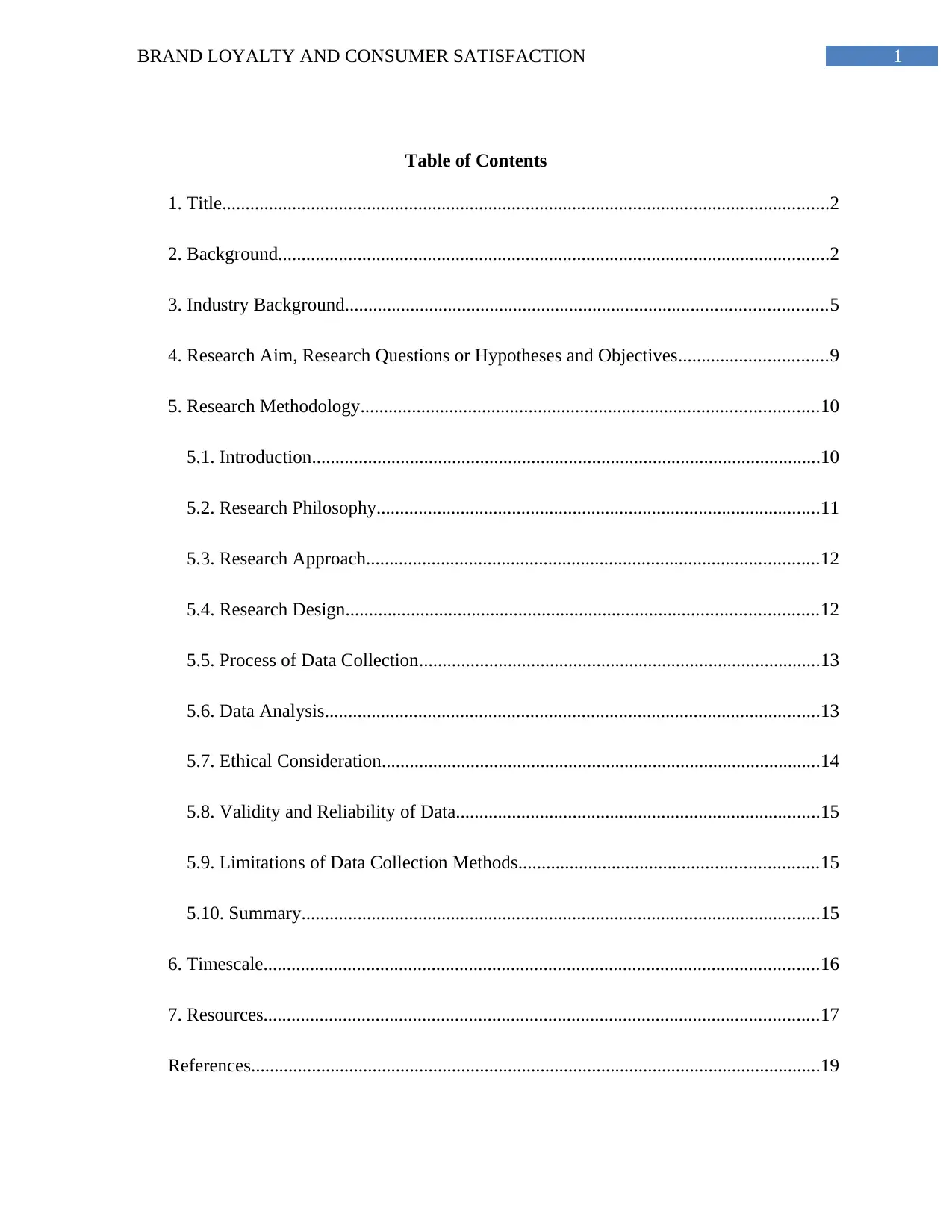
1BRAND LOYALTY AND CONSUMER SATISFACTION
Table of Contents
1. Title..................................................................................................................................2
2. Background......................................................................................................................2
3. Industry Background.......................................................................................................5
4. Research Aim, Research Questions or Hypotheses and Objectives................................9
5. Research Methodology..................................................................................................10
5.1. Introduction.............................................................................................................10
5.2. Research Philosophy...............................................................................................11
5.3. Research Approach.................................................................................................12
5.4. Research Design.....................................................................................................12
5.5. Process of Data Collection......................................................................................13
5.6. Data Analysis..........................................................................................................13
5.7. Ethical Consideration..............................................................................................14
5.8. Validity and Reliability of Data..............................................................................15
5.9. Limitations of Data Collection Methods................................................................15
5.10. Summary...............................................................................................................15
6. Timescale.......................................................................................................................16
7. Resources.......................................................................................................................17
References..........................................................................................................................19
Table of Contents
1. Title..................................................................................................................................2
2. Background......................................................................................................................2
3. Industry Background.......................................................................................................5
4. Research Aim, Research Questions or Hypotheses and Objectives................................9
5. Research Methodology..................................................................................................10
5.1. Introduction.............................................................................................................10
5.2. Research Philosophy...............................................................................................11
5.3. Research Approach.................................................................................................12
5.4. Research Design.....................................................................................................12
5.5. Process of Data Collection......................................................................................13
5.6. Data Analysis..........................................................................................................13
5.7. Ethical Consideration..............................................................................................14
5.8. Validity and Reliability of Data..............................................................................15
5.9. Limitations of Data Collection Methods................................................................15
5.10. Summary...............................................................................................................15
6. Timescale.......................................................................................................................16
7. Resources.......................................................................................................................17
References..........................................................................................................................19

2BRAND LOYALTY AND CONSUMER SATISFACTION
⊘ This is a preview!⊘
Do you want full access?
Subscribe today to unlock all pages.

Trusted by 1+ million students worldwide
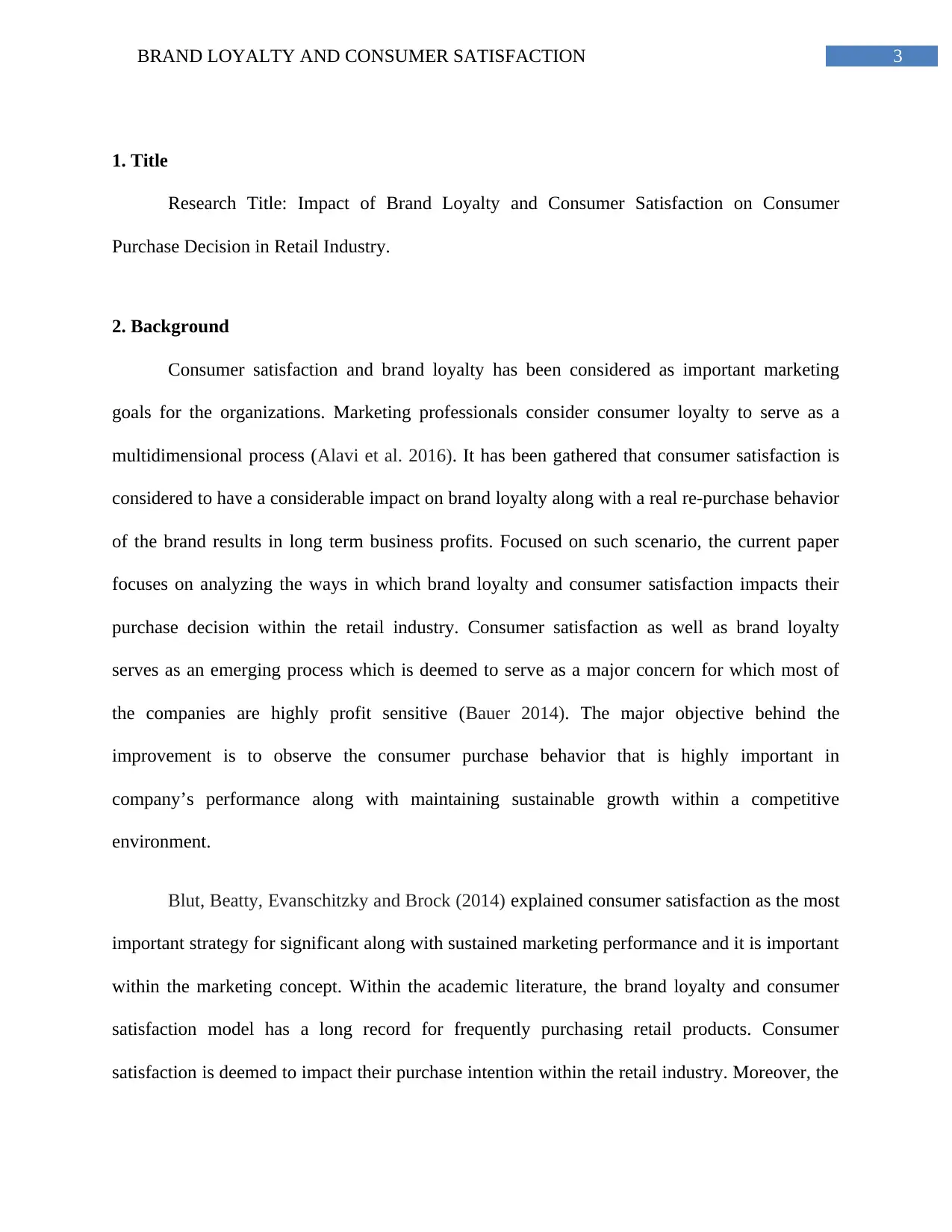
3BRAND LOYALTY AND CONSUMER SATISFACTION
1. Title
Research Title: Impact of Brand Loyalty and Consumer Satisfaction on Consumer
Purchase Decision in Retail Industry.
2. Background
Consumer satisfaction and brand loyalty has been considered as important marketing
goals for the organizations. Marketing professionals consider consumer loyalty to serve as a
multidimensional process (Alavi et al. 2016). It has been gathered that consumer satisfaction is
considered to have a considerable impact on brand loyalty along with a real re-purchase behavior
of the brand results in long term business profits. Focused on such scenario, the current paper
focuses on analyzing the ways in which brand loyalty and consumer satisfaction impacts their
purchase decision within the retail industry. Consumer satisfaction as well as brand loyalty
serves as an emerging process which is deemed to serve as a major concern for which most of
the companies are highly profit sensitive (Bauer 2014). The major objective behind the
improvement is to observe the consumer purchase behavior that is highly important in
company’s performance along with maintaining sustainable growth within a competitive
environment.
Blut, Beatty, Evanschitzky and Brock (2014) explained consumer satisfaction as the most
important strategy for significant along with sustained marketing performance and it is important
within the marketing concept. Within the academic literature, the brand loyalty and consumer
satisfaction model has a long record for frequently purchasing retail products. Consumer
satisfaction is deemed to impact their purchase intention within the retail industry. Moreover, the
1. Title
Research Title: Impact of Brand Loyalty and Consumer Satisfaction on Consumer
Purchase Decision in Retail Industry.
2. Background
Consumer satisfaction and brand loyalty has been considered as important marketing
goals for the organizations. Marketing professionals consider consumer loyalty to serve as a
multidimensional process (Alavi et al. 2016). It has been gathered that consumer satisfaction is
considered to have a considerable impact on brand loyalty along with a real re-purchase behavior
of the brand results in long term business profits. Focused on such scenario, the current paper
focuses on analyzing the ways in which brand loyalty and consumer satisfaction impacts their
purchase decision within the retail industry. Consumer satisfaction as well as brand loyalty
serves as an emerging process which is deemed to serve as a major concern for which most of
the companies are highly profit sensitive (Bauer 2014). The major objective behind the
improvement is to observe the consumer purchase behavior that is highly important in
company’s performance along with maintaining sustainable growth within a competitive
environment.
Blut, Beatty, Evanschitzky and Brock (2014) explained consumer satisfaction as the most
important strategy for significant along with sustained marketing performance and it is important
within the marketing concept. Within the academic literature, the brand loyalty and consumer
satisfaction model has a long record for frequently purchasing retail products. Consumer
satisfaction is deemed to impact their purchase intention within the retail industry. Moreover, the
Paraphrase This Document
Need a fresh take? Get an instant paraphrase of this document with our AI Paraphraser
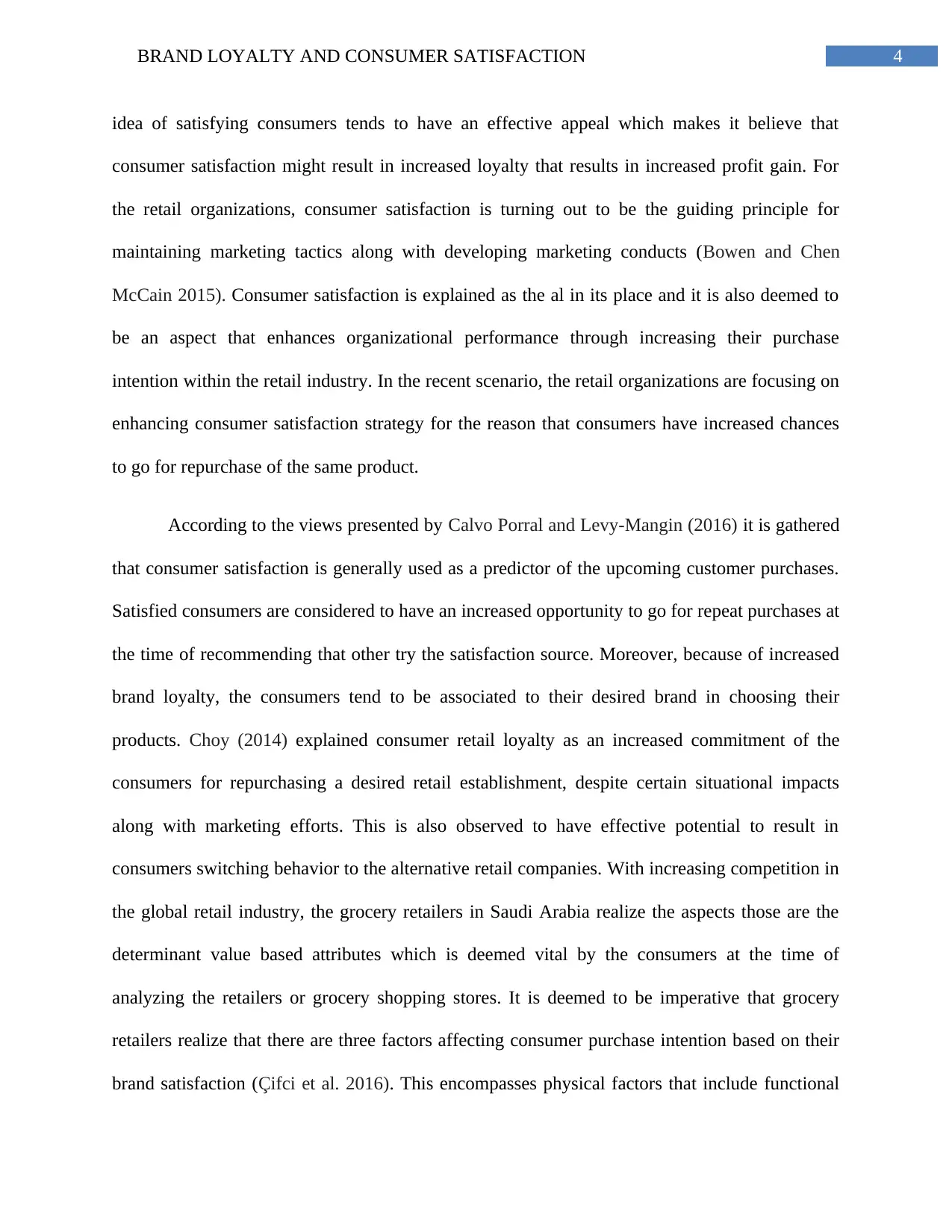
4BRAND LOYALTY AND CONSUMER SATISFACTION
idea of satisfying consumers tends to have an effective appeal which makes it believe that
consumer satisfaction might result in increased loyalty that results in increased profit gain. For
the retail organizations, consumer satisfaction is turning out to be the guiding principle for
maintaining marketing tactics along with developing marketing conducts (Bowen and Chen
McCain 2015). Consumer satisfaction is explained as the al in its place and it is also deemed to
be an aspect that enhances organizational performance through increasing their purchase
intention within the retail industry. In the recent scenario, the retail organizations are focusing on
enhancing consumer satisfaction strategy for the reason that consumers have increased chances
to go for repurchase of the same product.
According to the views presented by Calvo Porral and Levy-Mangin (2016) it is gathered
that consumer satisfaction is generally used as a predictor of the upcoming customer purchases.
Satisfied consumers are considered to have an increased opportunity to go for repeat purchases at
the time of recommending that other try the satisfaction source. Moreover, because of increased
brand loyalty, the consumers tend to be associated to their desired brand in choosing their
products. Choy (2014) explained consumer retail loyalty as an increased commitment of the
consumers for repurchasing a desired retail establishment, despite certain situational impacts
along with marketing efforts. This is also observed to have effective potential to result in
consumers switching behavior to the alternative retail companies. With increasing competition in
the global retail industry, the grocery retailers in Saudi Arabia realize the aspects those are the
determinant value based attributes which is deemed vital by the consumers at the time of
analyzing the retailers or grocery shopping stores. It is deemed to be imperative that grocery
retailers realize that there are three factors affecting consumer purchase intention based on their
brand satisfaction (Çifci et al. 2016). This encompasses physical factors that include functional
idea of satisfying consumers tends to have an effective appeal which makes it believe that
consumer satisfaction might result in increased loyalty that results in increased profit gain. For
the retail organizations, consumer satisfaction is turning out to be the guiding principle for
maintaining marketing tactics along with developing marketing conducts (Bowen and Chen
McCain 2015). Consumer satisfaction is explained as the al in its place and it is also deemed to
be an aspect that enhances organizational performance through increasing their purchase
intention within the retail industry. In the recent scenario, the retail organizations are focusing on
enhancing consumer satisfaction strategy for the reason that consumers have increased chances
to go for repurchase of the same product.
According to the views presented by Calvo Porral and Levy-Mangin (2016) it is gathered
that consumer satisfaction is generally used as a predictor of the upcoming customer purchases.
Satisfied consumers are considered to have an increased opportunity to go for repeat purchases at
the time of recommending that other try the satisfaction source. Moreover, because of increased
brand loyalty, the consumers tend to be associated to their desired brand in choosing their
products. Choy (2014) explained consumer retail loyalty as an increased commitment of the
consumers for repurchasing a desired retail establishment, despite certain situational impacts
along with marketing efforts. This is also observed to have effective potential to result in
consumers switching behavior to the alternative retail companies. With increasing competition in
the global retail industry, the grocery retailers in Saudi Arabia realize the aspects those are the
determinant value based attributes which is deemed vital by the consumers at the time of
analyzing the retailers or grocery shopping stores. It is deemed to be imperative that grocery
retailers realize that there are three factors affecting consumer purchase intention based on their
brand satisfaction (Çifci et al. 2016). This encompasses physical factors that include functional
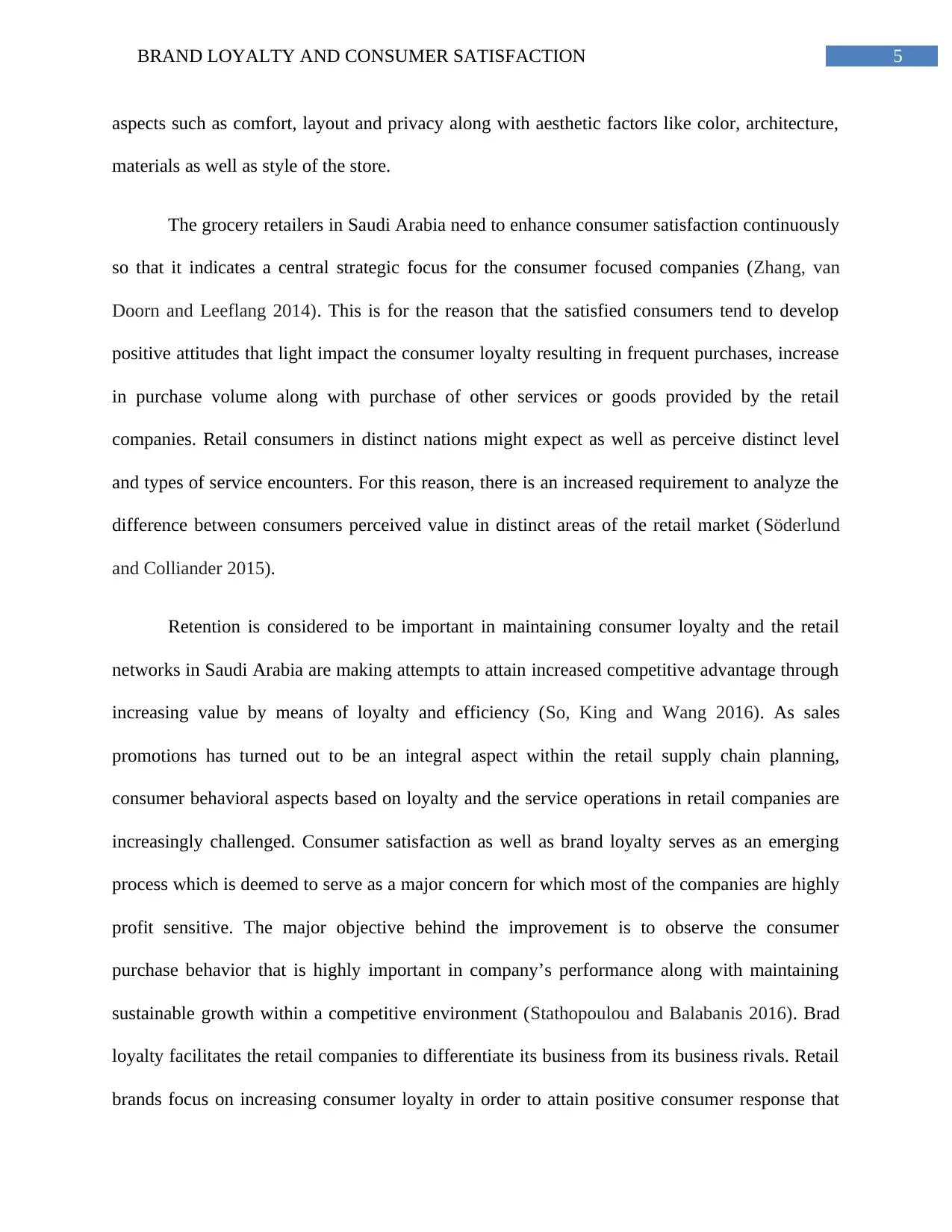
5BRAND LOYALTY AND CONSUMER SATISFACTION
aspects such as comfort, layout and privacy along with aesthetic factors like color, architecture,
materials as well as style of the store.
The grocery retailers in Saudi Arabia need to enhance consumer satisfaction continuously
so that it indicates a central strategic focus for the consumer focused companies (Zhang, van
Doorn and Leeflang 2014). This is for the reason that the satisfied consumers tend to develop
positive attitudes that light impact the consumer loyalty resulting in frequent purchases, increase
in purchase volume along with purchase of other services or goods provided by the retail
companies. Retail consumers in distinct nations might expect as well as perceive distinct level
and types of service encounters. For this reason, there is an increased requirement to analyze the
difference between consumers perceived value in distinct areas of the retail market (Söderlund
and Colliander 2015).
Retention is considered to be important in maintaining consumer loyalty and the retail
networks in Saudi Arabia are making attempts to attain increased competitive advantage through
increasing value by means of loyalty and efficiency (So, King and Wang 2016). As sales
promotions has turned out to be an integral aspect within the retail supply chain planning,
consumer behavioral aspects based on loyalty and the service operations in retail companies are
increasingly challenged. Consumer satisfaction as well as brand loyalty serves as an emerging
process which is deemed to serve as a major concern for which most of the companies are highly
profit sensitive. The major objective behind the improvement is to observe the consumer
purchase behavior that is highly important in company’s performance along with maintaining
sustainable growth within a competitive environment (Stathopoulou and Balabanis 2016). Brad
loyalty facilitates the retail companies to differentiate its business from its business rivals. Retail
brands focus on increasing consumer loyalty in order to attain positive consumer response that
aspects such as comfort, layout and privacy along with aesthetic factors like color, architecture,
materials as well as style of the store.
The grocery retailers in Saudi Arabia need to enhance consumer satisfaction continuously
so that it indicates a central strategic focus for the consumer focused companies (Zhang, van
Doorn and Leeflang 2014). This is for the reason that the satisfied consumers tend to develop
positive attitudes that light impact the consumer loyalty resulting in frequent purchases, increase
in purchase volume along with purchase of other services or goods provided by the retail
companies. Retail consumers in distinct nations might expect as well as perceive distinct level
and types of service encounters. For this reason, there is an increased requirement to analyze the
difference between consumers perceived value in distinct areas of the retail market (Söderlund
and Colliander 2015).
Retention is considered to be important in maintaining consumer loyalty and the retail
networks in Saudi Arabia are making attempts to attain increased competitive advantage through
increasing value by means of loyalty and efficiency (So, King and Wang 2016). As sales
promotions has turned out to be an integral aspect within the retail supply chain planning,
consumer behavioral aspects based on loyalty and the service operations in retail companies are
increasingly challenged. Consumer satisfaction as well as brand loyalty serves as an emerging
process which is deemed to serve as a major concern for which most of the companies are highly
profit sensitive. The major objective behind the improvement is to observe the consumer
purchase behavior that is highly important in company’s performance along with maintaining
sustainable growth within a competitive environment (Stathopoulou and Balabanis 2016). Brad
loyalty facilitates the retail companies to differentiate its business from its business rivals. Retail
brands focus on increasing consumer loyalty in order to attain positive consumer response that
⊘ This is a preview!⊘
Do you want full access?
Subscribe today to unlock all pages.

Trusted by 1+ million students worldwide
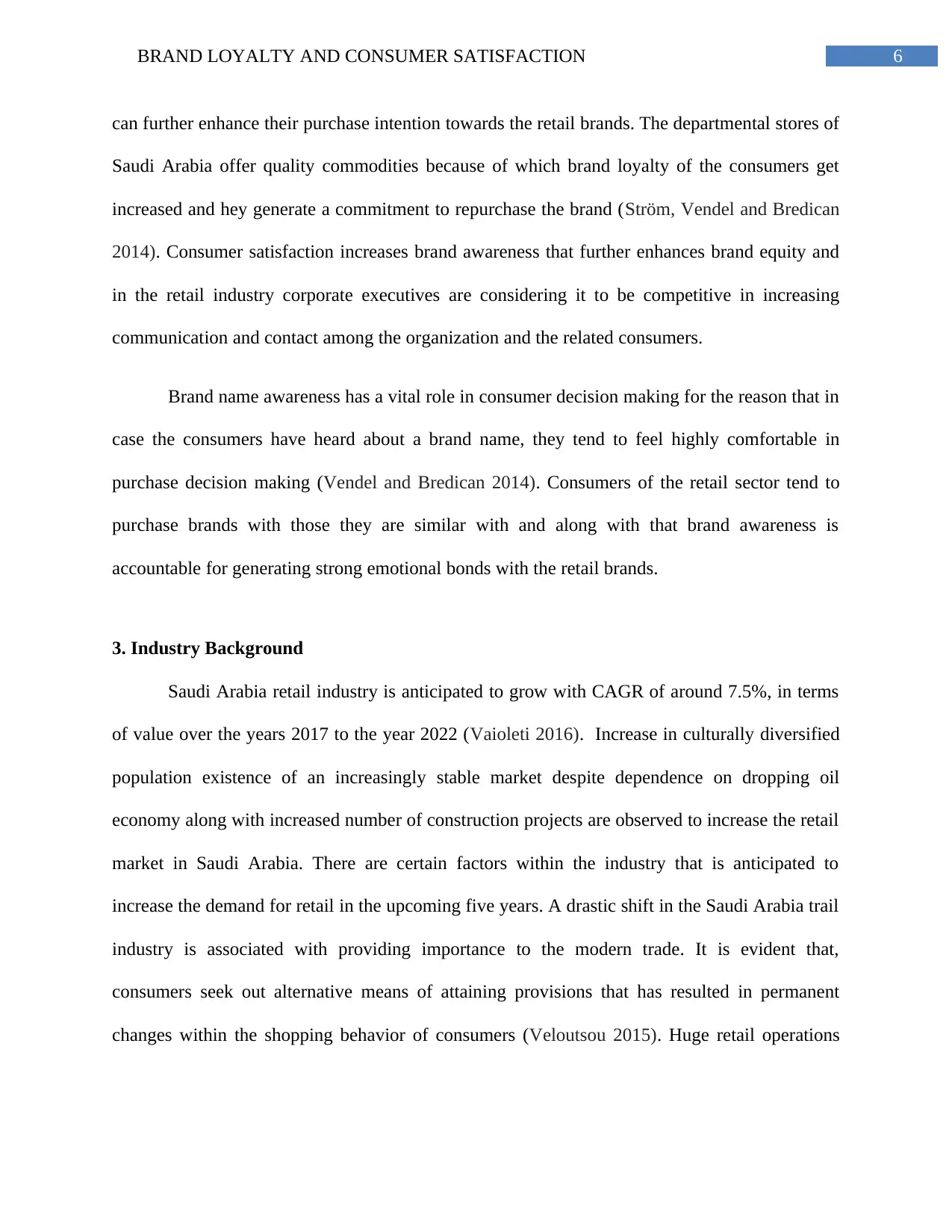
6BRAND LOYALTY AND CONSUMER SATISFACTION
can further enhance their purchase intention towards the retail brands. The departmental stores of
Saudi Arabia offer quality commodities because of which brand loyalty of the consumers get
increased and hey generate a commitment to repurchase the brand (Ström, Vendel and Bredican
2014). Consumer satisfaction increases brand awareness that further enhances brand equity and
in the retail industry corporate executives are considering it to be competitive in increasing
communication and contact among the organization and the related consumers.
Brand name awareness has a vital role in consumer decision making for the reason that in
case the consumers have heard about a brand name, they tend to feel highly comfortable in
purchase decision making (Vendel and Bredican 2014). Consumers of the retail sector tend to
purchase brands with those they are similar with and along with that brand awareness is
accountable for generating strong emotional bonds with the retail brands.
3. Industry Background
Saudi Arabia retail industry is anticipated to grow with CAGR of around 7.5%, in terms
of value over the years 2017 to the year 2022 (Vaioleti 2016). Increase in culturally diversified
population existence of an increasingly stable market despite dependence on dropping oil
economy along with increased number of construction projects are observed to increase the retail
market in Saudi Arabia. There are certain factors within the industry that is anticipated to
increase the demand for retail in the upcoming five years. A drastic shift in the Saudi Arabia trail
industry is associated with providing importance to the modern trade. It is evident that,
consumers seek out alternative means of attaining provisions that has resulted in permanent
changes within the shopping behavior of consumers (Veloutsou 2015). Huge retail operations
can further enhance their purchase intention towards the retail brands. The departmental stores of
Saudi Arabia offer quality commodities because of which brand loyalty of the consumers get
increased and hey generate a commitment to repurchase the brand (Ström, Vendel and Bredican
2014). Consumer satisfaction increases brand awareness that further enhances brand equity and
in the retail industry corporate executives are considering it to be competitive in increasing
communication and contact among the organization and the related consumers.
Brand name awareness has a vital role in consumer decision making for the reason that in
case the consumers have heard about a brand name, they tend to feel highly comfortable in
purchase decision making (Vendel and Bredican 2014). Consumers of the retail sector tend to
purchase brands with those they are similar with and along with that brand awareness is
accountable for generating strong emotional bonds with the retail brands.
3. Industry Background
Saudi Arabia retail industry is anticipated to grow with CAGR of around 7.5%, in terms
of value over the years 2017 to the year 2022 (Vaioleti 2016). Increase in culturally diversified
population existence of an increasingly stable market despite dependence on dropping oil
economy along with increased number of construction projects are observed to increase the retail
market in Saudi Arabia. There are certain factors within the industry that is anticipated to
increase the demand for retail in the upcoming five years. A drastic shift in the Saudi Arabia trail
industry is associated with providing importance to the modern trade. It is evident that,
consumers seek out alternative means of attaining provisions that has resulted in permanent
changes within the shopping behavior of consumers (Veloutsou 2015). Huge retail operations
Paraphrase This Document
Need a fresh take? Get an instant paraphrase of this document with our AI Paraphraser
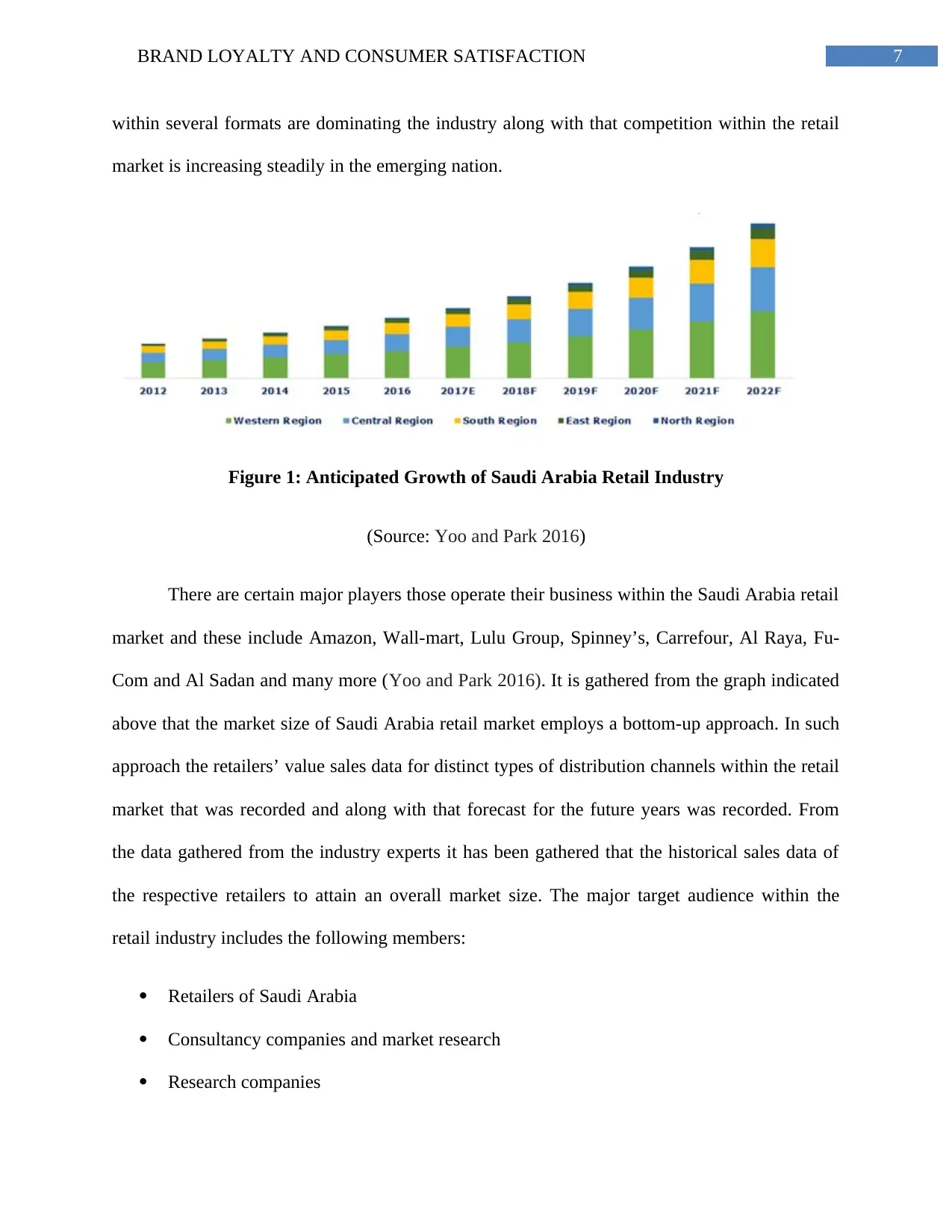
7BRAND LOYALTY AND CONSUMER SATISFACTION
within several formats are dominating the industry along with that competition within the retail
market is increasing steadily in the emerging nation.
Figure 1: Anticipated Growth of Saudi Arabia Retail Industry
(Source: Yoo and Park 2016)
There are certain major players those operate their business within the Saudi Arabia retail
market and these include Amazon, Wall-mart, Lulu Group, Spinney’s, Carrefour, Al Raya, Fu-
Com and Al Sadan and many more (Yoo and Park 2016). It is gathered from the graph indicated
above that the market size of Saudi Arabia retail market employs a bottom-up approach. In such
approach the retailers’ value sales data for distinct types of distribution channels within the retail
market that was recorded and along with that forecast for the future years was recorded. From
the data gathered from the industry experts it has been gathered that the historical sales data of
the respective retailers to attain an overall market size. The major target audience within the
retail industry includes the following members:
Retailers of Saudi Arabia
Consultancy companies and market research
Research companies
within several formats are dominating the industry along with that competition within the retail
market is increasing steadily in the emerging nation.
Figure 1: Anticipated Growth of Saudi Arabia Retail Industry
(Source: Yoo and Park 2016)
There are certain major players those operate their business within the Saudi Arabia retail
market and these include Amazon, Wall-mart, Lulu Group, Spinney’s, Carrefour, Al Raya, Fu-
Com and Al Sadan and many more (Yoo and Park 2016). It is gathered from the graph indicated
above that the market size of Saudi Arabia retail market employs a bottom-up approach. In such
approach the retailers’ value sales data for distinct types of distribution channels within the retail
market that was recorded and along with that forecast for the future years was recorded. From
the data gathered from the industry experts it has been gathered that the historical sales data of
the respective retailers to attain an overall market size. The major target audience within the
retail industry includes the following members:
Retailers of Saudi Arabia
Consultancy companies and market research
Research companies
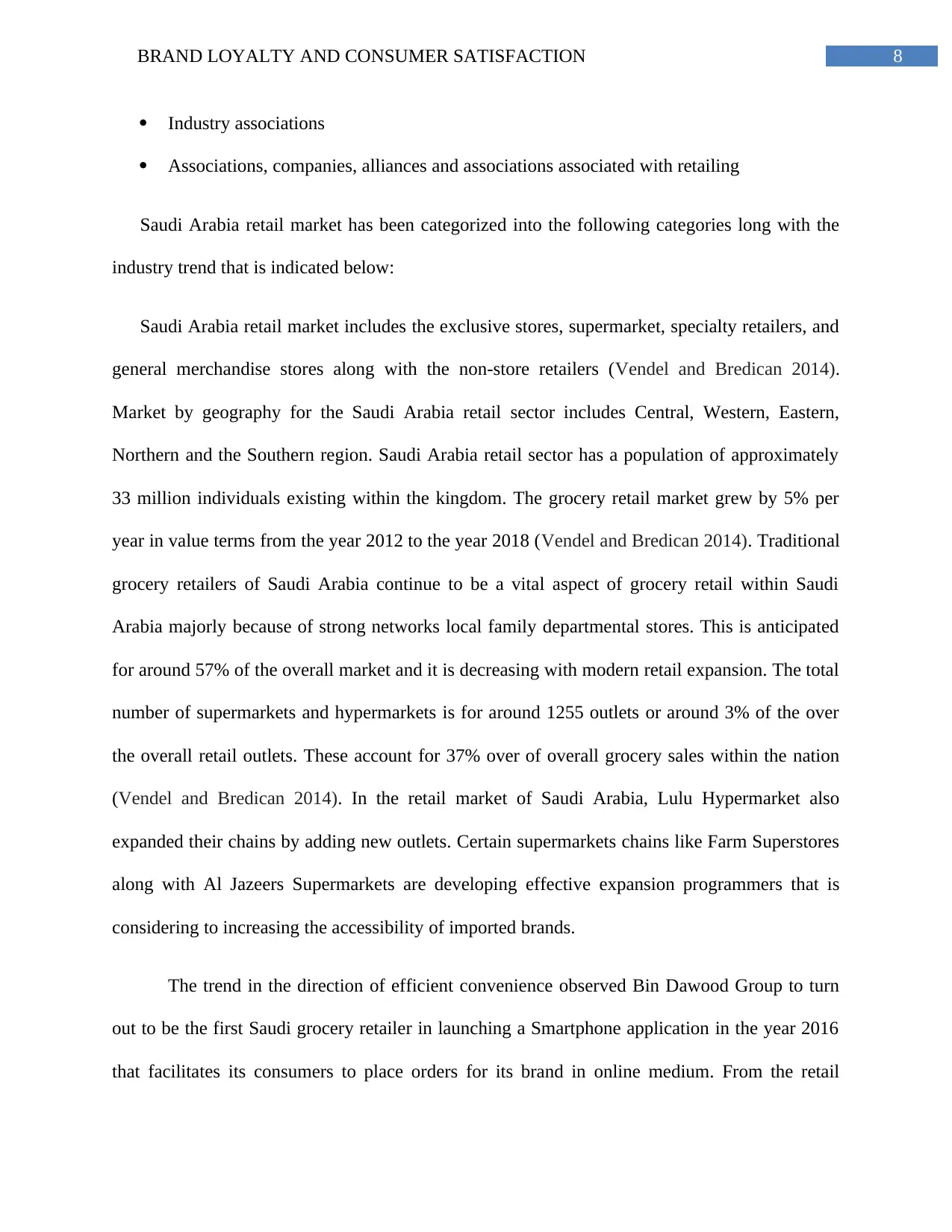
8BRAND LOYALTY AND CONSUMER SATISFACTION
Industry associations
Associations, companies, alliances and associations associated with retailing
Saudi Arabia retail market has been categorized into the following categories long with the
industry trend that is indicated below:
Saudi Arabia retail market includes the exclusive stores, supermarket, specialty retailers, and
general merchandise stores along with the non-store retailers (Vendel and Bredican 2014).
Market by geography for the Saudi Arabia retail sector includes Central, Western, Eastern,
Northern and the Southern region. Saudi Arabia retail sector has a population of approximately
33 million individuals existing within the kingdom. The grocery retail market grew by 5% per
year in value terms from the year 2012 to the year 2018 (Vendel and Bredican 2014). Traditional
grocery retailers of Saudi Arabia continue to be a vital aspect of grocery retail within Saudi
Arabia majorly because of strong networks local family departmental stores. This is anticipated
for around 57% of the overall market and it is decreasing with modern retail expansion. The total
number of supermarkets and hypermarkets is for around 1255 outlets or around 3% of the over
the overall retail outlets. These account for 37% over of overall grocery sales within the nation
(Vendel and Bredican 2014). In the retail market of Saudi Arabia, Lulu Hypermarket also
expanded their chains by adding new outlets. Certain supermarkets chains like Farm Superstores
along with Al Jazeers Supermarkets are developing effective expansion programmers that is
considering to increasing the accessibility of imported brands.
The trend in the direction of efficient convenience observed Bin Dawood Group to turn
out to be the first Saudi grocery retailer in launching a Smartphone application in the year 2016
that facilitates its consumers to place orders for its brand in online medium. From the retail
Industry associations
Associations, companies, alliances and associations associated with retailing
Saudi Arabia retail market has been categorized into the following categories long with the
industry trend that is indicated below:
Saudi Arabia retail market includes the exclusive stores, supermarket, specialty retailers, and
general merchandise stores along with the non-store retailers (Vendel and Bredican 2014).
Market by geography for the Saudi Arabia retail sector includes Central, Western, Eastern,
Northern and the Southern region. Saudi Arabia retail sector has a population of approximately
33 million individuals existing within the kingdom. The grocery retail market grew by 5% per
year in value terms from the year 2012 to the year 2018 (Vendel and Bredican 2014). Traditional
grocery retailers of Saudi Arabia continue to be a vital aspect of grocery retail within Saudi
Arabia majorly because of strong networks local family departmental stores. This is anticipated
for around 57% of the overall market and it is decreasing with modern retail expansion. The total
number of supermarkets and hypermarkets is for around 1255 outlets or around 3% of the over
the overall retail outlets. These account for 37% over of overall grocery sales within the nation
(Vendel and Bredican 2014). In the retail market of Saudi Arabia, Lulu Hypermarket also
expanded their chains by adding new outlets. Certain supermarkets chains like Farm Superstores
along with Al Jazeers Supermarkets are developing effective expansion programmers that is
considering to increasing the accessibility of imported brands.
The trend in the direction of efficient convenience observed Bin Dawood Group to turn
out to be the first Saudi grocery retailer in launching a Smartphone application in the year 2016
that facilitates its consumers to place orders for its brand in online medium. From the retail
⊘ This is a preview!⊘
Do you want full access?
Subscribe today to unlock all pages.

Trusted by 1+ million students worldwide
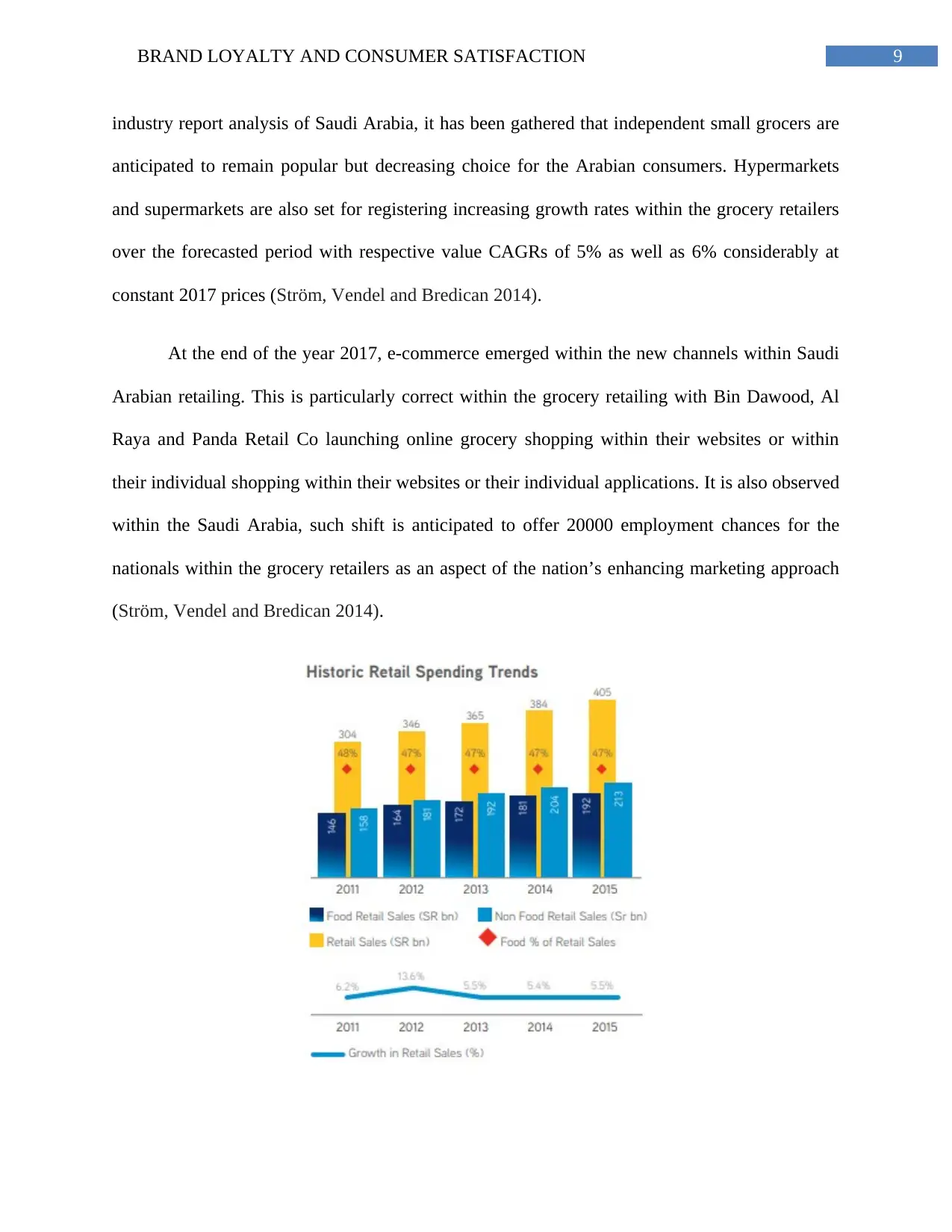
9BRAND LOYALTY AND CONSUMER SATISFACTION
industry report analysis of Saudi Arabia, it has been gathered that independent small grocers are
anticipated to remain popular but decreasing choice for the Arabian consumers. Hypermarkets
and supermarkets are also set for registering increasing growth rates within the grocery retailers
over the forecasted period with respective value CAGRs of 5% as well as 6% considerably at
constant 2017 prices (Ström, Vendel and Bredican 2014).
At the end of the year 2017, e-commerce emerged within the new channels within Saudi
Arabian retailing. This is particularly correct within the grocery retailing with Bin Dawood, Al
Raya and Panda Retail Co launching online grocery shopping within their websites or within
their individual shopping within their websites or their individual applications. It is also observed
within the Saudi Arabia, such shift is anticipated to offer 20000 employment chances for the
nationals within the grocery retailers as an aspect of the nation’s enhancing marketing approach
(Ström, Vendel and Bredican 2014).
industry report analysis of Saudi Arabia, it has been gathered that independent small grocers are
anticipated to remain popular but decreasing choice for the Arabian consumers. Hypermarkets
and supermarkets are also set for registering increasing growth rates within the grocery retailers
over the forecasted period with respective value CAGRs of 5% as well as 6% considerably at
constant 2017 prices (Ström, Vendel and Bredican 2014).
At the end of the year 2017, e-commerce emerged within the new channels within Saudi
Arabian retailing. This is particularly correct within the grocery retailing with Bin Dawood, Al
Raya and Panda Retail Co launching online grocery shopping within their websites or within
their individual shopping within their websites or their individual applications. It is also observed
within the Saudi Arabia, such shift is anticipated to offer 20000 employment chances for the
nationals within the grocery retailers as an aspect of the nation’s enhancing marketing approach
(Ström, Vendel and Bredican 2014).
Paraphrase This Document
Need a fresh take? Get an instant paraphrase of this document with our AI Paraphraser
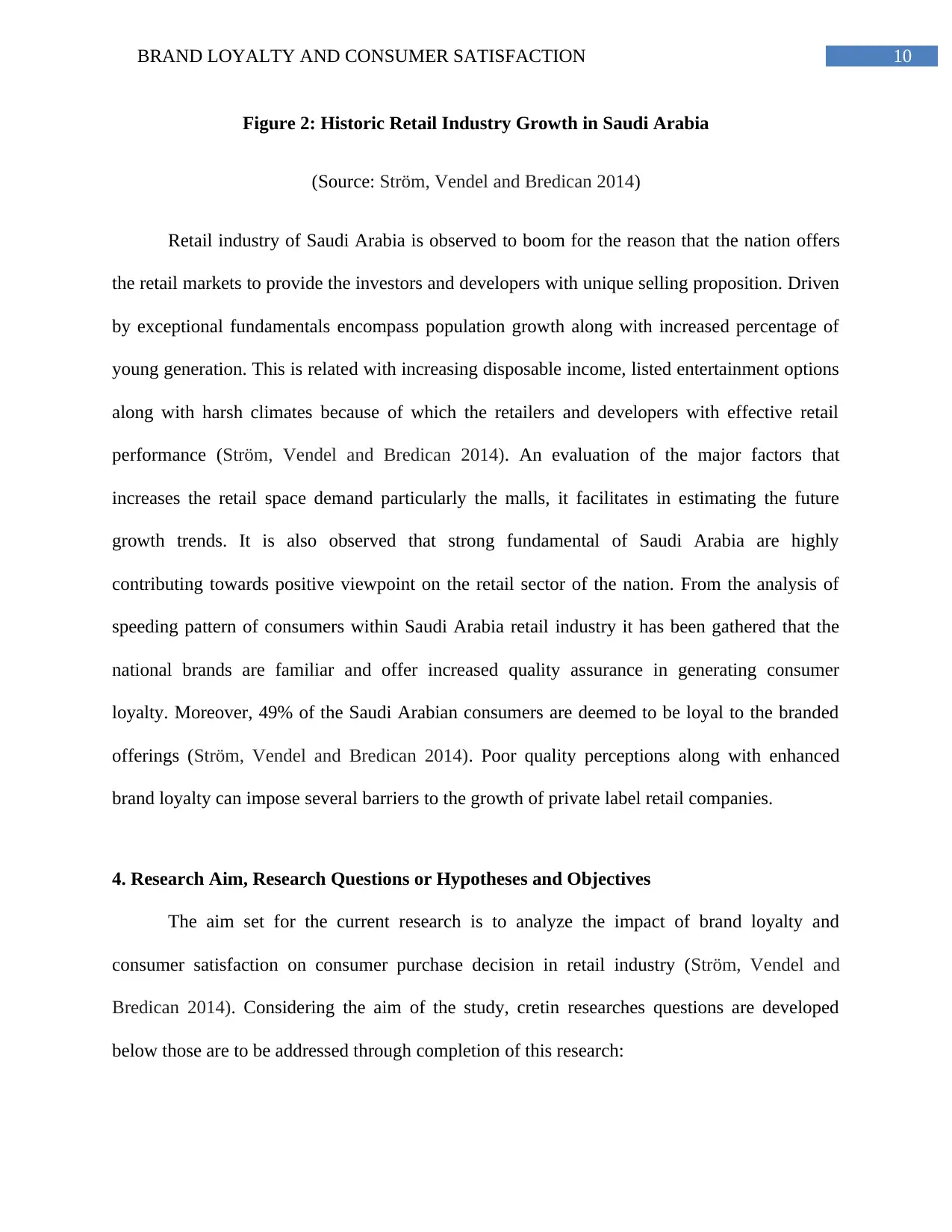
10BRAND LOYALTY AND CONSUMER SATISFACTION
Figure 2: Historic Retail Industry Growth in Saudi Arabia
(Source: Ström, Vendel and Bredican 2014)
Retail industry of Saudi Arabia is observed to boom for the reason that the nation offers
the retail markets to provide the investors and developers with unique selling proposition. Driven
by exceptional fundamentals encompass population growth along with increased percentage of
young generation. This is related with increasing disposable income, listed entertainment options
along with harsh climates because of which the retailers and developers with effective retail
performance (Ström, Vendel and Bredican 2014). An evaluation of the major factors that
increases the retail space demand particularly the malls, it facilitates in estimating the future
growth trends. It is also observed that strong fundamental of Saudi Arabia are highly
contributing towards positive viewpoint on the retail sector of the nation. From the analysis of
speeding pattern of consumers within Saudi Arabia retail industry it has been gathered that the
national brands are familiar and offer increased quality assurance in generating consumer
loyalty. Moreover, 49% of the Saudi Arabian consumers are deemed to be loyal to the branded
offerings (Ström, Vendel and Bredican 2014). Poor quality perceptions along with enhanced
brand loyalty can impose several barriers to the growth of private label retail companies.
4. Research Aim, Research Questions or Hypotheses and Objectives
The aim set for the current research is to analyze the impact of brand loyalty and
consumer satisfaction on consumer purchase decision in retail industry (Ström, Vendel and
Bredican 2014). Considering the aim of the study, cretin researches questions are developed
below those are to be addressed through completion of this research:
Figure 2: Historic Retail Industry Growth in Saudi Arabia
(Source: Ström, Vendel and Bredican 2014)
Retail industry of Saudi Arabia is observed to boom for the reason that the nation offers
the retail markets to provide the investors and developers with unique selling proposition. Driven
by exceptional fundamentals encompass population growth along with increased percentage of
young generation. This is related with increasing disposable income, listed entertainment options
along with harsh climates because of which the retailers and developers with effective retail
performance (Ström, Vendel and Bredican 2014). An evaluation of the major factors that
increases the retail space demand particularly the malls, it facilitates in estimating the future
growth trends. It is also observed that strong fundamental of Saudi Arabia are highly
contributing towards positive viewpoint on the retail sector of the nation. From the analysis of
speeding pattern of consumers within Saudi Arabia retail industry it has been gathered that the
national brands are familiar and offer increased quality assurance in generating consumer
loyalty. Moreover, 49% of the Saudi Arabian consumers are deemed to be loyal to the branded
offerings (Ström, Vendel and Bredican 2014). Poor quality perceptions along with enhanced
brand loyalty can impose several barriers to the growth of private label retail companies.
4. Research Aim, Research Questions or Hypotheses and Objectives
The aim set for the current research is to analyze the impact of brand loyalty and
consumer satisfaction on consumer purchase decision in retail industry (Ström, Vendel and
Bredican 2014). Considering the aim of the study, cretin researches questions are developed
below those are to be addressed through completion of this research:
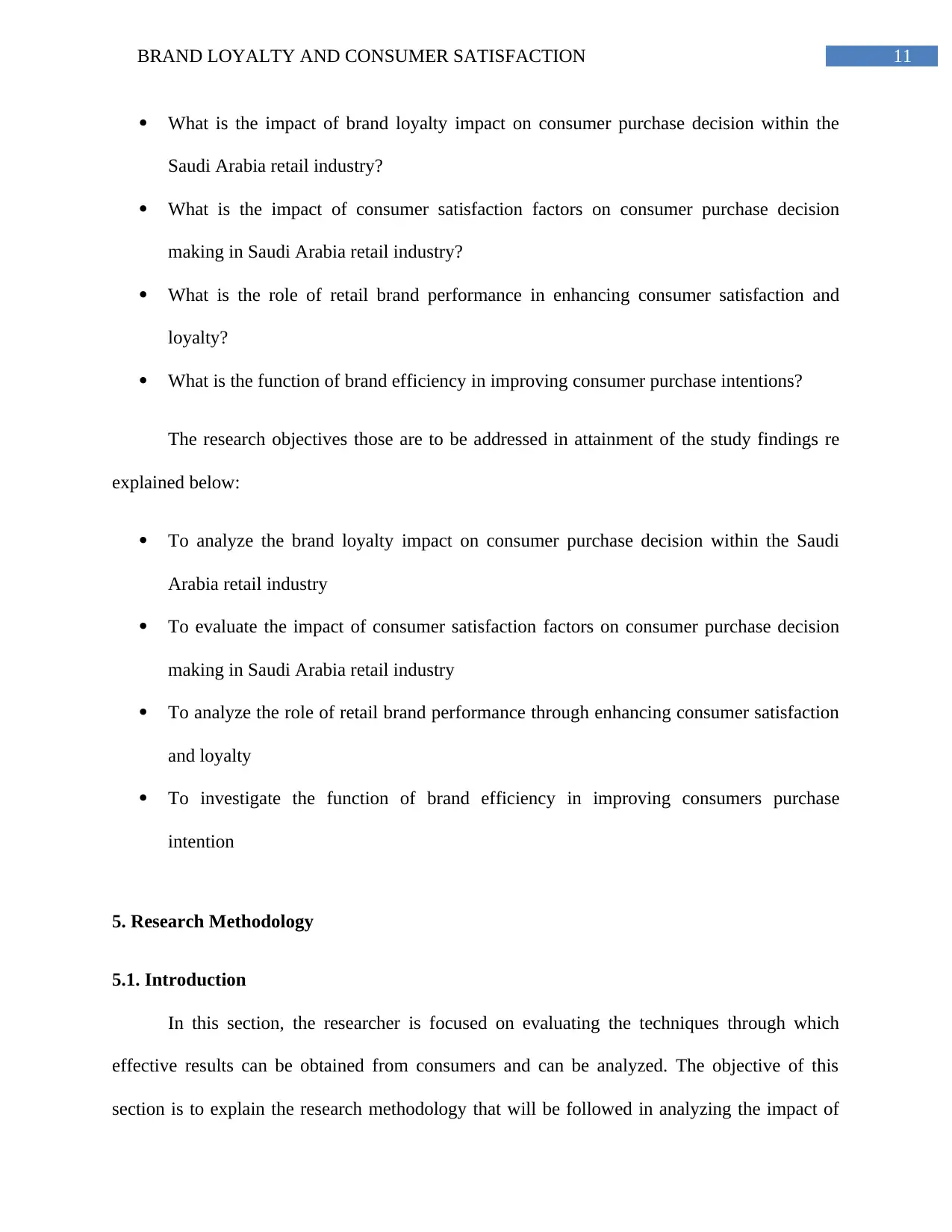
11BRAND LOYALTY AND CONSUMER SATISFACTION
What is the impact of brand loyalty impact on consumer purchase decision within the
Saudi Arabia retail industry?
What is the impact of consumer satisfaction factors on consumer purchase decision
making in Saudi Arabia retail industry?
What is the role of retail brand performance in enhancing consumer satisfaction and
loyalty?
What is the function of brand efficiency in improving consumer purchase intentions?
The research objectives those are to be addressed in attainment of the study findings re
explained below:
To analyze the brand loyalty impact on consumer purchase decision within the Saudi
Arabia retail industry
To evaluate the impact of consumer satisfaction factors on consumer purchase decision
making in Saudi Arabia retail industry
To analyze the role of retail brand performance through enhancing consumer satisfaction
and loyalty
To investigate the function of brand efficiency in improving consumers purchase
intention
5. Research Methodology
5.1. Introduction
In this section, the researcher is focused on evaluating the techniques through which
effective results can be obtained from consumers and can be analyzed. The objective of this
section is to explain the research methodology that will be followed in analyzing the impact of
What is the impact of brand loyalty impact on consumer purchase decision within the
Saudi Arabia retail industry?
What is the impact of consumer satisfaction factors on consumer purchase decision
making in Saudi Arabia retail industry?
What is the role of retail brand performance in enhancing consumer satisfaction and
loyalty?
What is the function of brand efficiency in improving consumer purchase intentions?
The research objectives those are to be addressed in attainment of the study findings re
explained below:
To analyze the brand loyalty impact on consumer purchase decision within the Saudi
Arabia retail industry
To evaluate the impact of consumer satisfaction factors on consumer purchase decision
making in Saudi Arabia retail industry
To analyze the role of retail brand performance through enhancing consumer satisfaction
and loyalty
To investigate the function of brand efficiency in improving consumers purchase
intention
5. Research Methodology
5.1. Introduction
In this section, the researcher is focused on evaluating the techniques through which
effective results can be obtained from consumers and can be analyzed. The objective of this
section is to explain the research methodology that will be followed in analyzing the impact of
⊘ This is a preview!⊘
Do you want full access?
Subscribe today to unlock all pages.

Trusted by 1+ million students worldwide
1 out of 25
Related Documents
Your All-in-One AI-Powered Toolkit for Academic Success.
+13062052269
info@desklib.com
Available 24*7 on WhatsApp / Email
![[object Object]](/_next/static/media/star-bottom.7253800d.svg)
Unlock your academic potential
Copyright © 2020–2025 A2Z Services. All Rights Reserved. Developed and managed by ZUCOL.





